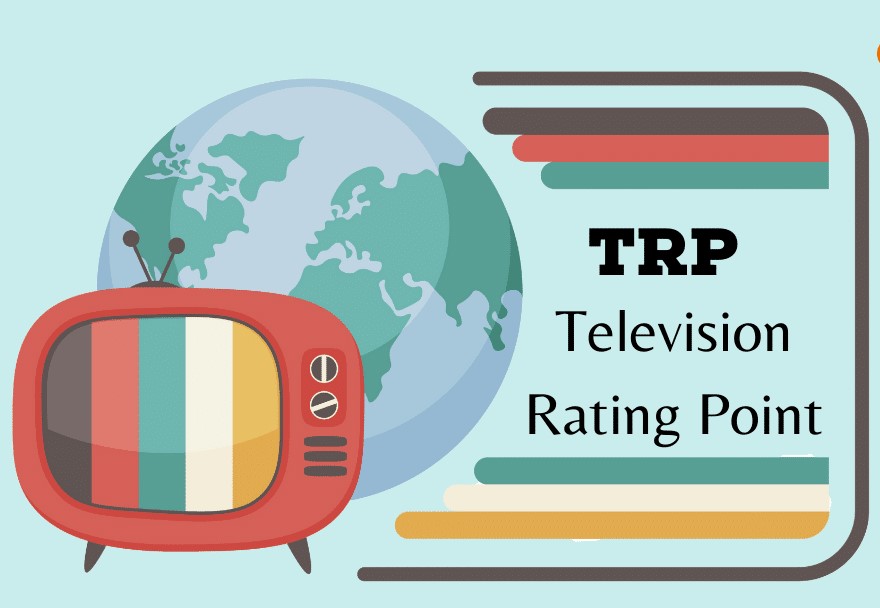The full form of TRP is Television Rating Point or Target Rating Point. TRP is a metric that signifies a programme’s success on tv screens. It is used to evaluate which programme has been most viewed on tv screens. TRP measures people’s interests and indicates a specific programme’s success. A programme with a greater TRP reflects many users viewing the programme. The data is essential to advertisers to measure the impressions of the target audience for a campaign.

The Role of TRPs in Television
Television Rating Points (TRPs) are calculated through diverse methods and audience measurement systems. These include:
- People’s Meters: Installed in panel homes, these devices track TV viewing habits, recording channel choices, viewing duration, and time.
- Set-Top Box Data: Set-top boxes equipped with tracking technology provide data on channel selection and viewing duration, often in real time.
- Diaries and Surveys: Some regions still use viewer diaries or surveys, where households manually record their TV habits.
- Return Path Data (RPD): Data transmitted through set-top boxes to service providers includes channel choices and viewing patterns.
- Online Streaming Data: Streaming platforms track what, how long, and who is streaming, integrating this data into TRP calculations.
- Hybrid Measurement: Many rating agencies combine methods like people’s meters, set-top box data, and online streaming to provide a comprehensive viewership overview.
- Metered Markets: Some systems focus on specific markets with a high concentration of panel homes or tracking-equipped set-top boxes.
- Demographic Breakdown: TRPs are often segmented by demographics, aiding targeted advertising.
- 24-Hour Data: TRP data collection spans 24 hours to cover all viewing times.
- Weekly and Monthly Ratings: TRP reports are typically published weekly or monthly, allowing stakeholders to monitor audience trends.
Various Method To Determine TRP
There are two techniques to measure the TRP value.
Picture Matching Method
Through this system, people meter monitor the tiny portion of the picture viewed on a specific TV set continuously. Afterwards, information is collected from the survey residences and used for TRP calculation.
Frequency Monitoring Technique
In this method, a people meter calculates the time and programme an audience watches on a given day. The average is obtained over 30 days.
Why is TRP Important?
- The answer to this question is money. A high TRP on a particular show means it has the attention of a large audience which implies that advertisers will pay more money to advertise on the channel
- High TRP guarantees more revenue and we all know that all the companies want to make more profit. At the same time, TRP helps in ranking the channel in this rat race. Creators and advertisers can understand the mindset of the audience
- TRP allows the creators to make content tailored to their needs. For example, Indian audiences love masala and drama in everything. However, due to the rise of web series and streaming platforms, the choices of the people are now refined and they give more importance to content-driven shows. But, still, there is a large group of people who love masala and drama
- Due to this, even the news channels don’t provide the facts truthfully and try to sensualise them in every way possible. The Indian audience loves watching things related to actors and their lives. This is the reason why many of the shows and news channels provide irrelevant news on famous actors.
Who Calculates TRP in India?
- TRP in India is calculated by the Indian Television Audience Measurement (INTAM) agency and Broadcast Audience Research Council (BARC)
- The BARC consists of the Indian broadcasters (IBF), advertisers (ISA), advertising and media agencies (AAAI)
- Earlier, Doordarshan Audience Research TV Ratings (DART) was used to calculate the TRP since at the time the only channel available to the audience was Doordarshan itself
- Although DART still exists and takes the viewing pattern of the people in rural areas into consideration. They randomly pick people and ask them about their viewing habits and also use electronic methods to evaluate TRP
Conclusion
Television Rating Points (TRPs) are a critical metric in the world of television broadcasting and advertising. They provide valuable insights into viewership patterns, program performance, and the effectiveness of advertising campaigns. TRPs influence scheduling decisions, content strategies, and targeted advertising efforts. They serve as a common language for stakeholders in the television industry, facilitating data-driven decision-making.
FAQs About TRP
Yes, TRP measurement methods and systems can vary by region or country. Different markets may use different technologies and sample sizes.
TRPs are typically reported on a weekly or monthly basis. This reporting frequency allows for tracking viewership trends over time.
TRPs do not directly measure content quality. They reflect viewership numbers but not the subjective quality of programs.
Yes, TRPs can influence content strategies. Networks may invest in certain genres or formats based on what resonates with viewers, as indicated by TRP data.
Related posts:
- AMC Full Form: Benefits, Components, Needs, Advantage
- ORS Full Form: Dehydration, Myths, Flavors, Varieties & Facts
- PCC Full Form: Importance, Types, Application Process
- PAN Full Form: Legal Provisions, Regulations,
- BRB Full Form: Productive, Routine, Distractions
- MCD Full From: Introduction, Responsibility, Challenges
- CT Scan Full Form: Scans, price, Advantages
- USA Full Form: History, Economics,Technology, culture




















